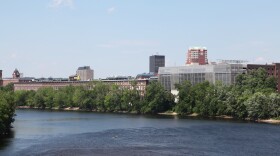The Nature Conservancy and the University of New Hampshire are working to restore oyster beds in the Great Bay. The organization hopes its efforts can help stave off an ecosystem collapse while towns in the watershed work toward upgrading their wastewater plants.
In Stratham, where the Squamscott river empties into the Great Bay, there’s a barge anchored in the middle of the water with a crane attached. It’s emptying big one ton bags of what looks like rocky fill into the brackish water.
Konisky: this is our fourth year working together, doing this type of project, we figured out a while back that the system here didn’t have enough hard bottom, enough substrate in it, and what we’re doing today is replacing that.
Ray Konisky from the Nature Conservancy says that each bag contains a mix of clam and oyster shells, collected from seafood restaurants and fishermen. They dump them on the floor of the Great Bay so that young Oysters, called spat, can take root on them.
Konisky: So this is just natural recruitment, there’s oyster larvae in the water, we’re working next to a reef. So we’re getting somewhere between 2 and 10 spat per square meter, which is as good as we’re getting on natural reefs so it’s not bad. [trails off chatting]
The project is a collaboration between the Nature Conservancy, and the University of New Hampshire. Every year, they try to restore about 2 acres of oyster beds per year; a number they’d like to be able to ramp up to 5 acres. It’s paid for by money cobbled together from grants from things like the moose license plate program, and some local conservation commissions, at a cost of about $100,000 dollars per acre.
Back in 1800's there were around 1,000 acres of Oyster beds here, but a combination of overharvesting, disease, and pollution has knocked that back to less than 50 acres. Many of those diseases are imported from Europe. And Ray Grizzle of UNH says they’ve been trying to create a more resistant oyster breed, but oysters are still dying at elevated rates.
Grizzle: the sad part of it is that now, in NH, pretty much the whole Eastern Seaboard, you don’t find an oyster more than three to five years, so these are large oysters, but this is about as old as they get.
It’s maybe hard to understand why a group would invest so much time and money in seeding oysters, but the animals are more than just a high-priced aphrodisiac
The director of the Nature Conservancy in New Hampshire, Daryl Burtnett, says his group at first was interested in restoring a historic wildlife population. But they realized their work could also help keep the Great Bay’s ecosystem as a whole healthy.
He says, oysters as filter feeders can help clean nitrogen pollution out of water released by wastewater plants. Those who watch the Great Bay say that because of that pollution the ecosystem there is dangerously close to a collapse.
Burtnett: So the Oysters I think can buy us time on that, they can contribute to pulling nutrients out, they can clarify the water enough. And if we can ramp this up quickly enough, I think we can make it through the next half-decade or so to the point where the towns will find a solution to deal with the waste water. So this is a piece in a pretty complex puzzle.
No one can say how close the Great Bay is to the tipping point after which it would be too late. Or if a half-decade will be enough time to clean up the wastewater flooding the Great Bay. But for now the best hope may lie with thousandsof oysters at the bottom of the river.










